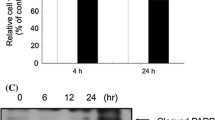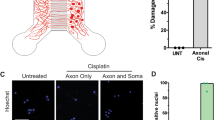Abstract
MPP+ (1-methyl-4-phenylpyridium ion), a complex I — inhibiting metabolite of 1-methyl-4-phe-nyl-1,2,3,6-tetrahydropyridine (MPTP), causes anatomic-specific neurodegeneration. To evaluate the broader role of mitochondria in MPP+- induced cell death, we exposed neuron-like NT2 human teratocarcinoma cells with mtDNA(rho+) and without mtDNA (rho0) to MPP+. MPP+ minimized the ability of both rho+ and rho0 cells to reduce MTT. Only rho+ cells, though, initiated intrinsic pathway-mediated apoptosis. MPP+ also activated calpains in rho0 cell lines. The calpain inhibitor MDL 28710 was able to prevent the MPP+-related MTT reduction change in rho0 but not rho+ cells. We conclude that 1) MPP+-induced apoptosis requires functional mitochondria, 2) MPP+ activates calpains independent of respiratory chain inhibition, and 3) calpain activation mediates some aspects of MPP+ toxicity.
Similar content being viewed by others
References
AttardiG and G Schatz (1988) Biogenesis of mitochondria.Annu. Rev. Cell Biol. 4, 289–333.
Bayir H, B Fadeel, MJ Palladino, E Witasp, IV Kurnikov, YY Tyurina, VA Tyurin, AA Amoscato, J Jiang, PM Kochanek, ST DeKosky, JS Greenberger, AA Shvedova and VE Kagan (2006) Apoptotic interactions of cytochromec: redox flirting with anionic phospholipids within and outside of mitochondria.Biochim. Biophys. Acta 1757, 648–659.
Bergmeyer HU and E. Brent (1974) UV-assay with pyruvate and NADH, In:Methods ofEnzimatic Analysis (Bergmeyer HU, Ed.) (Academic Press:New York), pp 547–559.
Binder DR, WH Dunn Jr and RH Swerdlow (2005) Molecular characterization of mtDNA depleted and repleted NT2 cell lines.Mitochondrion 5, 255–265.
Bradford MM (1976) A rapid and sensitive method for the quantitation of microgram quantities of protein utilizing the principle of protein-dye binding.Anal. Biochem. 72, 248–254.
Burns RS, CC Chiueh, SP Markey, MH Ebert, DM Jacobowitz and IJ Kopin (1983) A primate model of parkinsonism: selective destruction of dopaminergic neurons in the pars compacta of the substantia nigra by N-methyl-4-phenyl-1,2,3,6-tetrahydropyridine.Proc. Natl. Acad. Sci. USA 80, 4546–4550.
Camins A, E Verdaguer, J Folch and M Pallas (2006) Involvement of calpain activation in neurodegenerative processes.CNS Drug Rev. 12, 135–148.
Cardoso SM, S Santos, RH Swerdlow and CR Oliveira (2001) Functional mitochondria are required for amyloid betamediated neurotoxicity.FASEB J. 15, 1439–1441.
Cardoso SM, PI Moreira, P Agostinho, C Pereira and CR Oliveira (2005) Neurodegenerative pathways in Parkinson’s disease: therapeutic strategies.Curr. Drug Targets CNS Neurol. Disord. 4, 405–419.
Chan P, LE DeLanney, I Irwin, JW Langston and MD Di (1991) Rapid ATP loss caused by 1-methyl-4-phenyl-1,2,3,6-tetrahydropyridine in mouse brain.J. Neurochem. 57, 348–351.
Chera B, KE Schaecher, A Rocchini, SZ Imam, EA Sribnick, SK Ray, SF Ali and NL Banik (2004) Immunofluorescent labeling of increased calpain expression and neuronal death in the spinal cord of 1-methyl-4-phenyl-1,2,3,6-tetrahydro-pyridine-treated mice.Brain Res. 1006, 150–156
Cregan SP, JG MacLaurin, CG Craig, GS Robertson, DW Nicholson, DS Park and RS Slack (1999) Bax-dependent caspase-3 activation is a key determinant in p53-induced apoptosis in neurons.J. Neurosci. 19, 7860–7869.
Crocker SJ, PD Smith, V Jackson-Lewis, WR Lamba, SP Hayley, E Grimm, SM Callaghan, RS Slack, E Melloni, S Przedborski, GS Robertson, H Anisman, Z Merali and DS Park (2003) Inhibition of calpains prevents neuronal and behavioral deficits in an MPTP mouse model of Parkinson’s disease.J. Neurosci. 23, 4081–4091.
Davis GC, AC Williams, SP Markey, MH Ebert, ED Caine, CM Reichert and IJ Kopin, (1979) Chronic Parkinsonism secondary to intravenous injection of meperidine analogues.Psychiatry Res. 1, 249–254
Ekinci FJ and TB Shea (1999) Hyperactivation of mitogen-activated protein kinase increases phospho-tau immunoreactivity within human neuroblastoma: additive and synergistic influence of alteration of additional kinase activities.Cell Mol. Neurobiol. 19, 249–260.
Fabre E, J Monserrat, A Herrero, G Barja and ML Leret (1999) Effect of MPTP on brain mitochondrial H2O2 and ATP production and on dopamine and DOPAC in the striatum.J. Physiol. Biochem. 55, 325–331.
Hald A and J Lotharius (2005) Oxidative stress and inflammation in Parkinson’s disease: is there a causal link?Exp. Neurol. 193, 279–290.
Hasegawa E, K Takeshige, T Oishi, Y Murai and S Minakami (1990) 1-Methyl-4-phenylpyridinium (MPP+) induces NADH-dependent superoxide formation and enhances NADH-dependent lipid peroxidation in bovine heart submitochondrial particles.Biochem. Biophys. Res. Commun. 170, 1049–1055.
Hasegawa E, D Kang, K Sakamoto, A Mitsumoto, T Nagano, S Minakami and K Takeshige (1997) A dual effect of 1-methyl-4-phenylpyridinium (MPP+)-analogs on the respiratory chain of bovine heart mitochondria.Arch. Biochem. Biophys. 337, 69–74.
Heikkila RE (1984) Pharmacological basis of therapeutics: dopamine receptors.J. Med. Soc. N. J. 81, 1084–1086.
Jiang S, J Cai, DC Wallace and DP Jones (1999) Cytochrome c-mediated apoptosis in cells lacking mitochondrial DNA. signaling pathway involving release and caspase 3 activation is conserved.J. Biol. Chem. 274, 29905–29911.
Johnson GV and RP Guttmann (1997) Calpains: intact and active?Bioessays 19, 1011–1018.
Macho A, T Hirsch, I Marzo, P Marchetti, B Dallaporta, SA Susin, N Zamzami and G Kroemer (1997) Glutathione depletion is an early and calcium elevation is a late event of thymocyte apoptosis.J. Immunol. 158, 4612–4619.
McNaught KS and P Jenner (2001) Proteasomal function is impaired in substantia nigra in Parkinson’s disease.Neurosci. Lett. 297, 191–194.
Mosmann T (1983) Rapid colorimetric assay for cellular growth and survival: application to proliferation and cytotoxicity assays.J. Immunol. Methods 65, 55–63.
Mouatt-Prigent A, JO Karlsson, Y Agid and EC Hirsch (1996) Increased M-calpain expression in the mesencephalon of patients with Parkinson’s disease but not in other neurodegenera- tive disorders involving the mesencephalon: a role in nerve cell death?Neuroscience 73, 979–987.
Nakagawa T and J Yuan (2000) Cross-talk between two cysteine protease families. Activation of caspase-12 by calpain in apoptosis.J. Cell Biol. 150, 887–894.
Parker WD Jr, SJ Boyson and JK Parks (1989) Abnormalities of the electron transport chain in idiopathic Parkinson’s disease.Ann. Neurol. 26, 719–723.
Ren Y, W Liu, H Jiang, Q Jiang and J Feng (2005) Selective vulnerability of dopaminergic neurons to microtubule depo-lymerization.J. Biol. Chem. 280, 34105–34112.
Samantaray S, SK Ray, SF Ali and NL Banik (2006) Calpain activation in apoptosis of motoneurons in cell culture models of experimental parkinsonism.Ann. NY Acad. Sci. 1074, 349–356.
Samantaray S, VH Knaryan, MK Guyton, DD Matzelle, SK Ray and NL Banik (2007) The parkinsonian neurotoxin rotenone activates calpain and caspase-3 leading to motoneuron degeneration in spinal cord of Lewis rats.Neuroscience 146, 741–755.
Schapira AH, JM Cooper, D Dexter, JB Clark, P Jenner and CD Marsden (1990) Mitochondrial complex I deficiency in Parkinson’s disease.J. Neurochem. 54, 823–827.
Sponne I, A Fifre, B Drouet, C Klein, V Koziel, M Pincon-Raymond, JL Olivier, J Chambaz and T Pillot (2003) Apoptotic neuronal cell death induced by the non-fibrillar amyloid-beta peptide proceeds through an early reactive oxygen species-dependent cytoskeleton perturbation.J. Biol. Chem. 278, 3437–3445.
Swerdlow RH, JK Parks, DS Cassarino, DJ Maguire, RS Maguire, JP Bennett, RE Davis Jr and WD Parker Jr (1997) Cybrids in Alzheimer’s disease: a cellular model of the disease?Neurology 49, 918–925.
Yamakawa H, Y Banno, S Nakashima, S Yoshimura, M Sawada, Y Nishimura, Y Nozawa and N Sakai (2001) Crucial role of calpain in hypoxic PC 12 cell death: calpain, but not caspases, mediates degradation of cytoskeletal proteins and protein kinase C-α and -δ.Neurol. Res. 23, 522–530.
Zou H, Y Li, X Liu and X Wang (1999) An APAF-1 cytochromec multimeric complex is a functional apoptosome that activates procaspase-9.J. Biol. Chem. 274, 11549–11556.
Author information
Authors and Affiliations
Corresponding author
Rights and permissions
About this article
Cite this article
Domingues, A.F., Esteves, A.R.F., Swerdlow, R.H. et al. Calpain-mediated MPP+ toxicity in mitochondrial DNA depleted cells. neurotox res 13, 31–38 (2008). https://doi.org/10.1007/BF03033365
Received:
Revised:
Issue Date:
DOI: https://doi.org/10.1007/BF03033365




